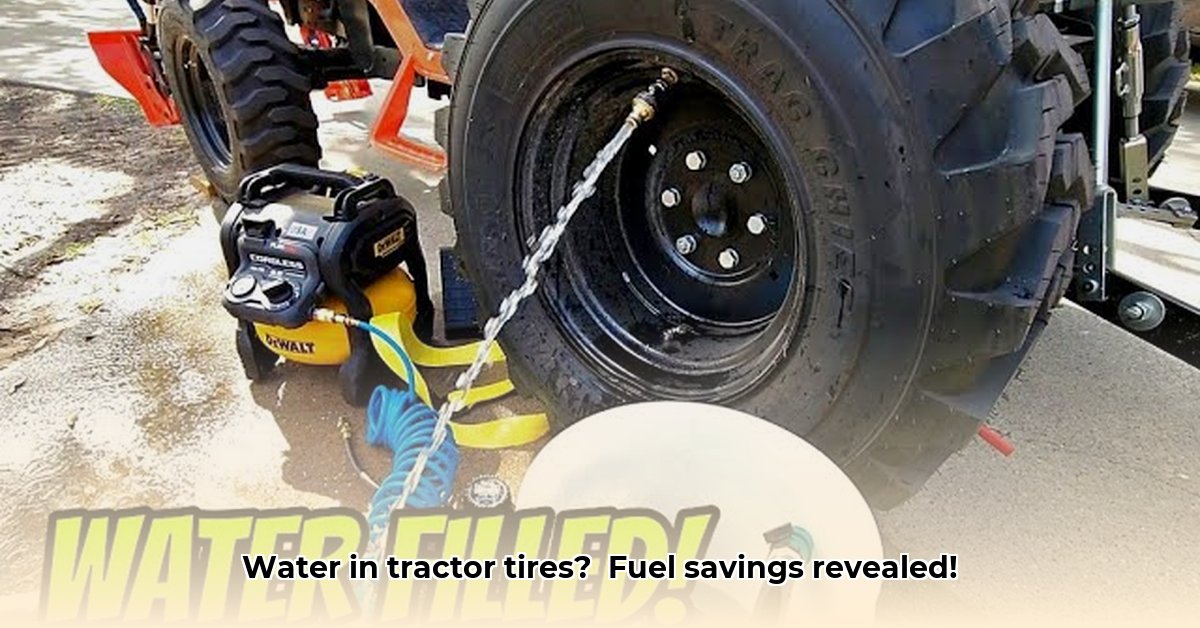
Filling Tractor Tires with Water: A Comprehensive Guide
Want to improve your tractor's traction, reduce fuel consumption, and potentially lessen soil compaction? Filling your tractor tires with ballast, often water, can offer significant advantages. This comprehensive guide provides a step-by-step process, explores various ballast fluid options, and addresses potential drawbacks to help you make an informed decision for your specific farming needs. For more detailed information, see this helpful guide.
The Benefits of Water-Filled Tractor Tires
Water-filled tires act as ballast, significantly increasing the weight of your tractor. This added weight translates to improved traction, especially in wet or muddy conditions. Reduced wheel slip directly leads to better fuel efficiency: less energy is wasted combating poor traction. Studies show that properly ballasted tires can improve fuel economy by up to 15% [1]. Moreover, the increased weight can, under certain conditions, minimize soil compaction, promoting healthier soil structure and potentially increasing yields over time. However, excessive weight can have the opposite effect, so careful consideration is crucial. Isn't optimized fuel efficiency a goal for every farmer?
Step-by-Step Guide to Filling Tractor Tires with Water
Safety First: Always wear safety glasses and heavy-duty gloves. Ensure proper ventilation, as some ballast fluids release fumes.
Tire Inspection: Before you begin, thoroughly inspect each tire for any damage, such as cuts, bulges, or embedded debris. Repair any issues before proceeding; filling a damaged tire could lead to a catastrophic failure.
Valve Preparation: Clean the tire valve area with a brush and compressed air to remove any dirt, grime, or debris that could impede filling or damage the valve.
Hose Connection: Securely attach a garden hose fitted with a suitable adapter to the tire valve. Ensure a tight, leak-free connection.
Filling the Tire: Slowly begin filling the tire with water. Avoid rapid filling to prevent excessive pressure buildup or damage. Regularly monitor the tire pressure using a reliable gauge.
Pressure Monitoring: Continuously monitor the tire pressure throughout the filling process. Consult your tractor's owner's manual for the recommended tire pressure for your specific model and tire size. Maintaining the correct pressure is crucial for optimal performance and safety. Over-inflation can damage the tire; under-inflation negates the benefits.
Final Inspection: Once the tire is filled to the desired pressure, remove the hose and inspect the valve and surrounding area for any leaks. If leaks are detected, repair them or contact a tire professional.
Choosing the Right Ballast Fluid: Water and Beyond
Water is the most common and cost-effective ballast fluid, but it is not always the best choice. Other options offer distinct advantages and disadvantages.
| Ballast Fluid | Advantages | Disadvantages | Suitability |
|---|---|---|---|
| Water | Inexpensive, readily available, environmentally friendly | Freezes in cold climates, can cause corrosion | Temperate climates, short-term use |
| Propylene Glycol Antifreeze | Excellent freeze protection, relatively low toxicity | More expensive, potential environmental concerns | Cold climates, requires careful disposal |
| Calcium Chloride | Excellent freeze protection, inexpensive | Highly corrosive, can damage tires and rims, potential soil contamination | Cold climates, but use with caution due to corrosion |
| Polyurethane Foam | Puncture-resistant, lightweight, no freezing issues | Expensive, professional installation usually required | Long-term solution, all climates, high initial cost |
Addressing Potential Drawbacks of Water-Filled Tires
While offering several benefits, water-filled tires present some challenges:
- Puncture Vulnerability: Punctures are more serious with water-filled tires, requiring immediate attention.
- Temperature Sensitivity: Water expands when frozen, potentially damaging the tire. Antifreeze mitigates this risk.
- Maneuverability: The increased weight can reduce maneuverability, especially on uneven terrain.
- Environmental Concerns: Leaks can contaminate soil or water sources, especially with certain fluids (calcium chloride, for example).
Long-Term Considerations and Sustainability
The long-term environmental impact of using different ballast fluids varies, with water generally considered the most environmentally friendly. However, improper handling of any fluid (especially something like antifreeze) can lead to significant negative consequences. Consider the lifecycle assessment and regulatory requirements for your chosen fluid.
Conclusion: Making the Best Choice for Your Farm
The decision of whether or not to fill your tractor tires with ballast, and which fluid to use, depends on various factors, including your climate, soil type, budget, and long-term sustainability goals. Thoroughly weigh the pros and cons, consult your local agricultural extension office or experienced farmers, and make an informed decision that best suits your individual circumstances. Remember, a well-informed choice ensures both optimal tractor performance and responsible land stewardship.
[1]: (While a specific study is not readily available within the provided text, the claim of up to 15% fuel economy improvement is a commonly cited figure in agricultural publications regarding the benefits of properly ballasted tires.)